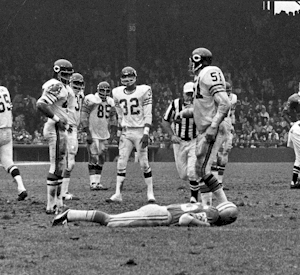What Damar Hamlin Did (and Didn’t) Teach Us About Football
“Those who cannot remember the past are condemned to repeat it.”
— George Santayana
Many have heard this famous adage, but as I’ve seen the events of Damar Hamlin’s tumultuous injury and recovery play out, I’ve wondered just how many people are taking this sentiment to heart. Incidents like this have happened before in football, and the fact that it has happened once again calls to question just how much we care about making sports as safe as they can be.
On January 2nd, the football world held its breath after Hamlin, a Buffalo Bills safety, suddenly collapsed in the wake of a routine play during a game against the Cincinnati Bengals. As medics were called in to respond to a sudden cardiac arrest, the game was delayed, and eventually cancelled, out of respect for Hamlin and his condition. After Hamlin was stabilized in the hospital, questions immediately started flying: How could this have happened? Was everyone acting safely during the play? What can be done to prevent this from happening in the future? For a few weeks, as Hamlin recovered, it seemed as if the NFL was in for some major reform in terms of player safety.
. . . and then, nothing happened. Hamlin’s recovery started out smoothly, the regular season turned to the playoffs, and there weren’t any groundbreaking announcements about the future safety of NFL players. Everything went back to normal after all the hullaballoo, and the world moved on to other things. As I took all of this in, I was disappointed, but not surprised. After all, something even worse than Hamlin’s situation had already played out before in the form of Chuck Hughes.
Hughes was an average football player who had been with the Detroit Lions for several years in the early seventies. After an uneventful career with a few minor injuries, everything ground to a halt when he collapsed on the field during a game against the Chicago Bears on October 24, 1971. By the time adequate medical help arrived and transported him to a hospital, all they could do was pronounce him dead at 5:34 PM.

The game was played out in stunned silence, and while it was properly acknowledged as a tragedy, the full truth only came to light later on: that Hughes’ previous injuries had been improperly treated in an effort to get him playing again ASAP. Had doctors taken a closer look, they could have easily predicted Hughes’ heart failure and prevented it from happening. Instead, he played on and paid the ultimate price for virtually nothing. He was hardly memorialized, and the issue of player safety was barely brought up. Nobody learned their lesson, and the same thing has now happened again, more than 50 years later.
Some key points are different between the stories of Hamlin and Hughes, though. Most obvious is the fact that Hamlin (luckily) did not die and is currently making a steady recovery. In addition, the NFL cancelled Hamlin’s game out of respect for the gravity of the situation, something the 1971 version of the league failed to do. This is a big step in the right direction, but it’s not enough: There’s still too much of a risk that this modern incident doesn’t lead to anything substantial in terms of player safety reform.
The question remains, though: even if a reform effort was launchced, what then? What would change? Football is, at heart, a game of people running into each other at full force. All Damar Hamlin did was make a routine tackle; what could we change about that without fundamentally altering the sport of football itself? As much as the aftermath of Hamlin’s injury has shown the possibility of fans and management banding together in their concern for a player’s well-being, it also exposes a much darker truth: no matter how sympathetic any amount of people may be, the juggernaut that is pro football has little consideration for any individual player’s health and, as past and present have come to show us, will always prefer to move on and let fans enjoy the game rather than take a moment to stop and think about if a sign of a larger problem has just passed by.
In the end, football is an entertaining, albeit monstrously unsafe, sport that countless people enjoy. What Damar Hamlin and his tragic injury have shown all of these people is that for all of the progress toward making player’s careers as safe as possible, football remains an inherently dangerous sport that can easily crush someone’s hopes of living a normal, healthy life in a single instant. The only question that remains now is if we can all slow down and take in the full ramifications of these kinds of injuries, or if football will once again just go on, waiting for history to repeat itself all over again.
